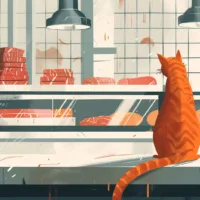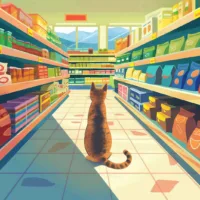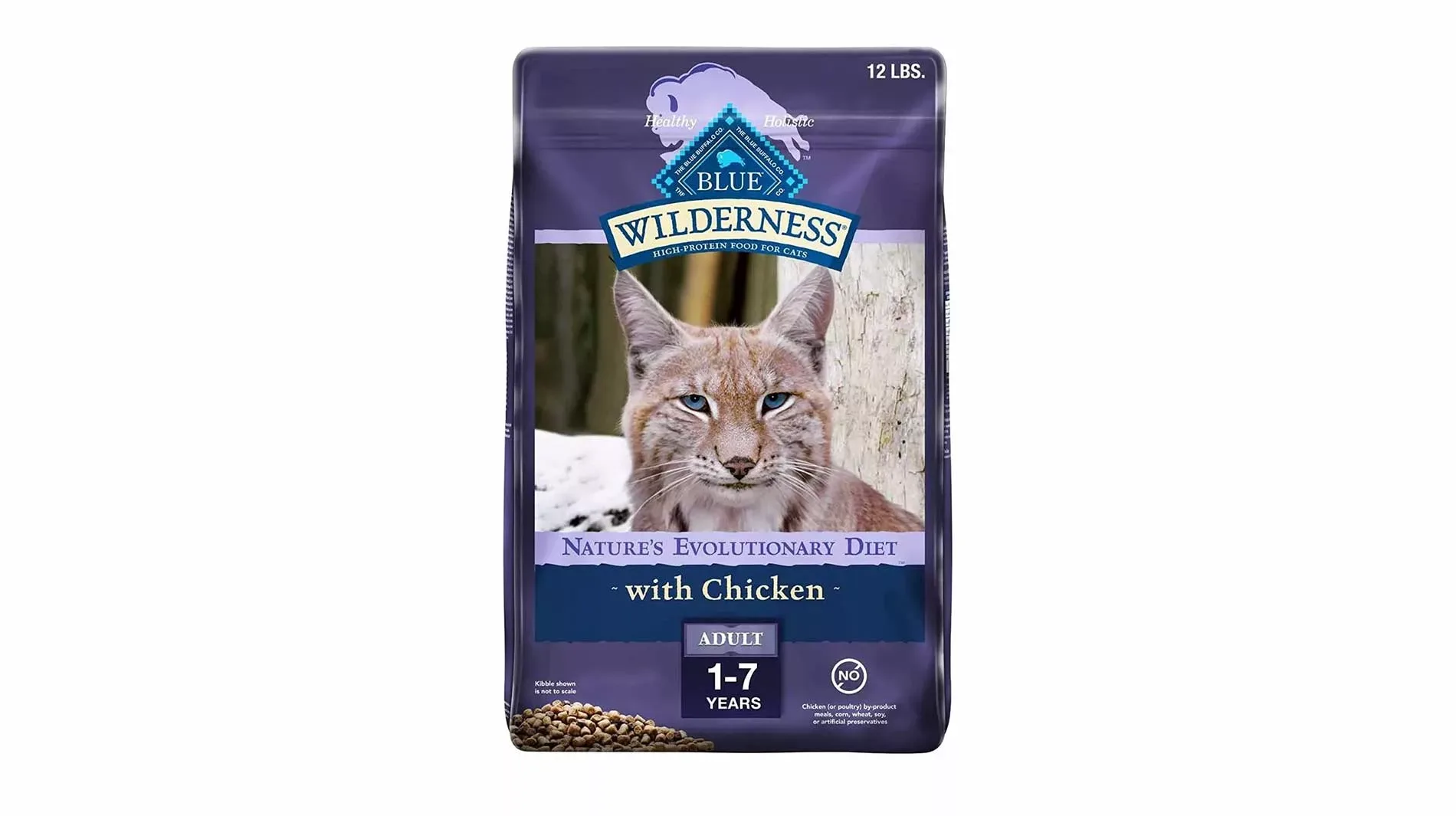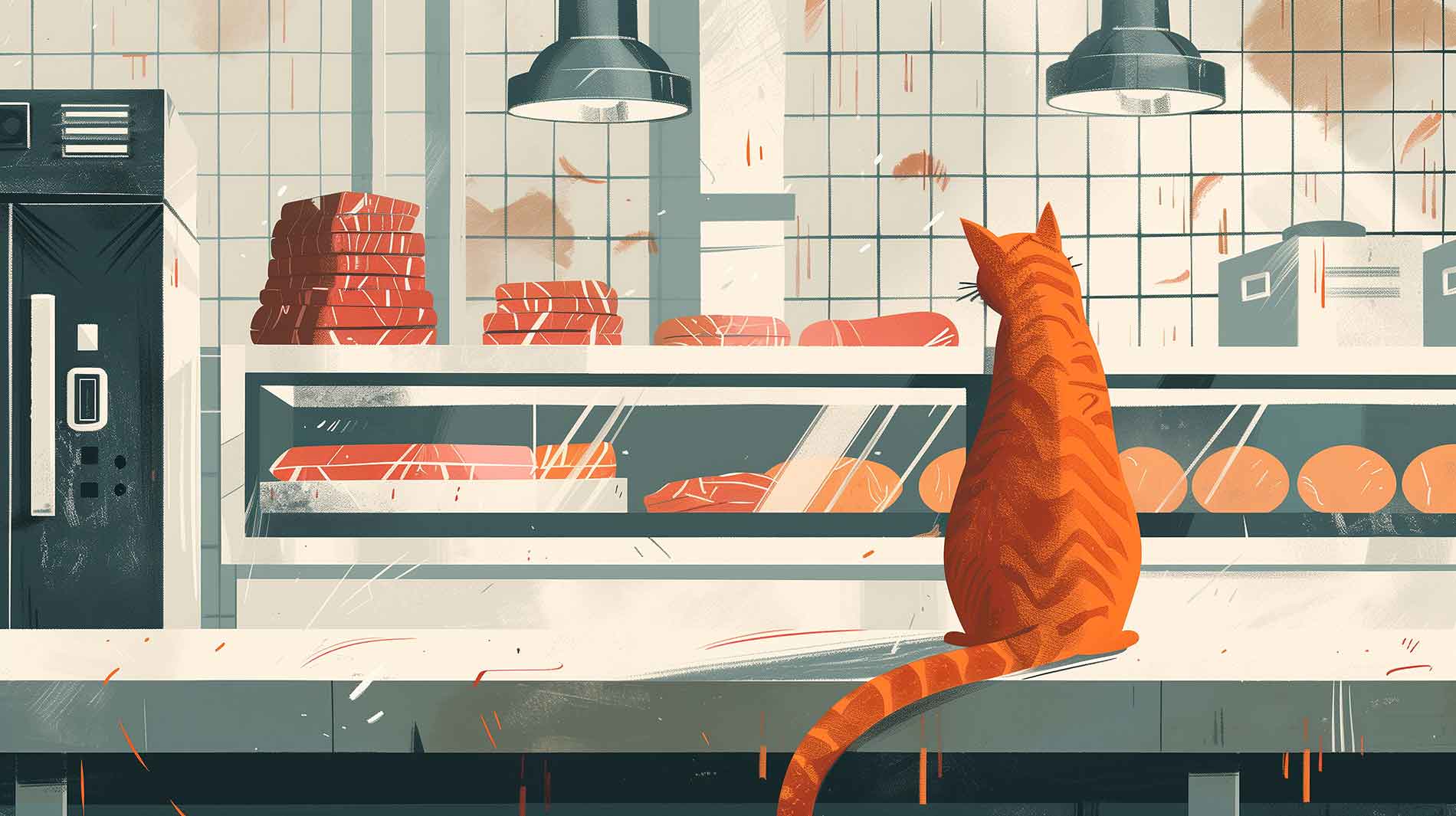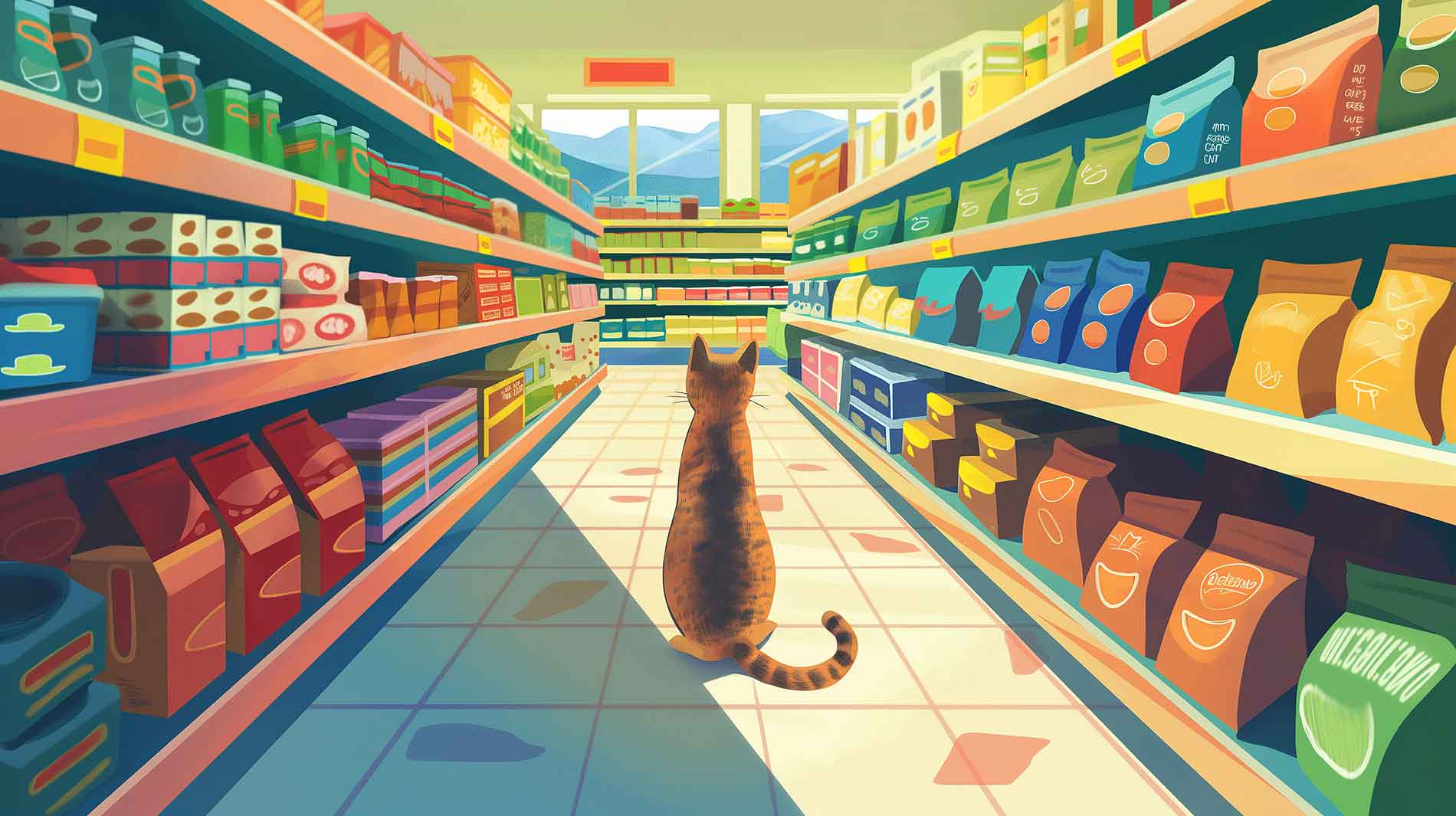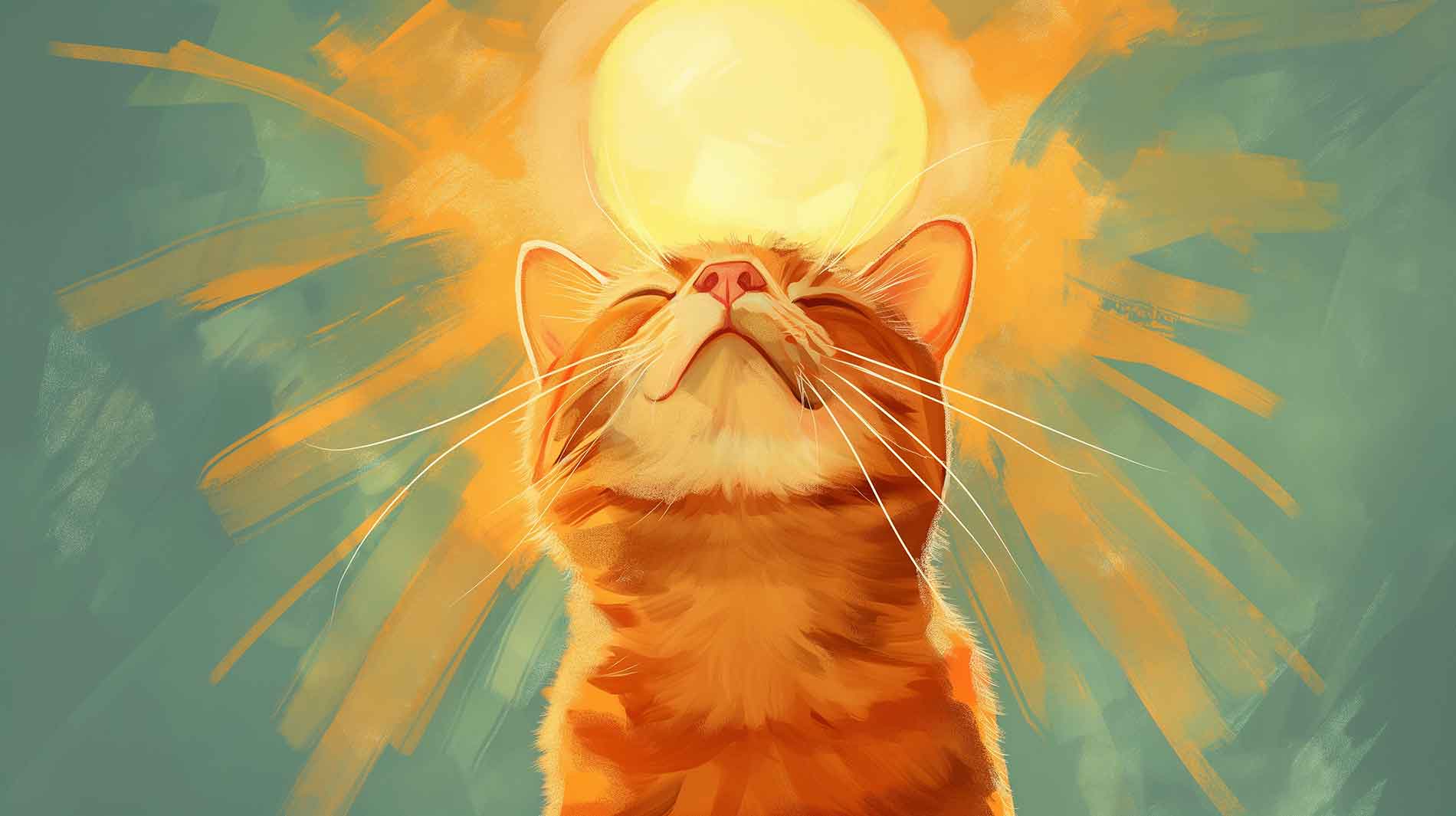Today, we’re taking a close look at Blue Buffalo’s dry chicken food and sharing our review with you. We’ve used a variety of criteria to give you an accurate and transparent assessment. So let’s get right to the Blue Buffalo chicken dry food review!
If you’re curious, you can check out our criteria page to find out exactly how the rating was arrived at.
1. The Blue Wilderness chicken dry food composition – we have a lot to point out
The declaration of crude ash is not mandatory for American cat food, although some manufacturers may list it in the guaranteed analysis. In order to calculate anything, we’ll estimate an average of 6.5% of crude ash. Please consider this while checking out the price (caloric content) and the carbohydrate content / NFE. We’re unable to estimate how much of this product is meat as Blue Buffalo has not declared the percentage of any of the ingredients. In dry matter, this food contains about 44% proteins and 25% carbohydrates.
We noted that the only source of animal meat in this product is ‘deboned chicken,’ which is listed as the first ingredient. It’s somewhat surprising to find no offal included in this formulation, despite the rich nutritional value these animal organs can offer. For instance, liver is an excellent source of vitamin A, the heart is abundant in taurine, and kidneys are high in certain B vitamins. If such organ meats were included in the formulation, it could enhance the nutritional value of the food significantly and lessen the need for the additional supplementation of vitamins and minerals. Thus, we encourage the manufacturers to reconsider the product’s composition, potentially reducing the use of three different types of meals, tapioca starch, and dried egg product.
Blue Buffalo’s “Blue Wilderness” Chicken uses unnecessary ingredients
Like many kibble-based cat foods, this product contains a number of ingredients that cats simply don’t need. So settle in with a cup of coffee, as we’re about to dive into an extensive list:
Potatoes
The potato, as a member of the nightshade family, can pose risks to cats due to its content of potentially toxic substances like solanine, nicotine, lectins, and alkaloids. While cooking can reduce these toxins, it also decreases nutrient content. Furthermore, potatoes offer limited benefits to cats as they are rich in carbohydrates, which cats need only minimally and have difficulty processing effectively. The use of such ingredients in cat food doesn’t align with cats’ natural dietary requirements.
Legumes
Just like potatoes, legumes present similar problems in a cat’s diet. They can be harmful when raw and their high carbohydrate content is ill-suited for cats’ minimal carbohydrate needs. With their plant origins and the inevitable nutrient loss from extensive processing for kibble, legumes, too, clearly deviate from a cat’s natural dietary requirements.
- Peas and pea protein. As obligate carnivores, cats have a limited ability to utilize plant-based proteins. Consequently, pea protein, derived from legumes, does not provide essential dietary value for cats, marking it as unnecessary.
- Dehydrated alfalfa meal. Also known as lucerne, it’s valued for its high mineral content. However, the dehydration, grinding, and cooking processes required to incorporate it into cat food can significantly diminish these nutrients. Until there’s scientific evidence supporting the benefits of adding prebiotics to a healthy cat’s diet, the additional fiber content from alfalfa meal is considered unnecessary. Thus, dehydrated alfalfa meal primarily serves as a filler ingredient and is not beneficial for your cat’s well-being.
Natural Flavor
While this might make the food more palatable for cats, it doesn’t provide any nutritional benefits. The specific source of the flavor is also important to consider.
Dried chicory root, salt, sweet potatoes, carrots, vegetable juice for color, blueberries, cranberries, barley grass, parsley, turmeric, and dried kelp.
These ingredients primarily serve as sources of fiber or color. While they may have some nutritional value, they are not essential for cats who are carnivores.
Yucca Schidigera Extract
This is often used to control the odor of cat feces and urine but doesn’t provide significant nutritional value for cats.
Dried Enterococcus faecium fermentation product, Dried Lactobacillus acidophilus fermentation product, Dried Aspergillus niger fermentation extract, Dried Trichoderma longibrachiatum fermentation extract, Dried Bacillus subtilis fermentation extract.
These are all sources of probiotics, which can aid in digestion. The benefits of probiotics for cats are still being studied and their inclusion in cat food is not necessary.
Plant-based oils
Flaxseed oil and oil of rosemary are both plant-based oils, and as such, they contain types of fats that cats can’t utilize as effectively as animal fats.
- Flaxseed oil is high in alpha-linolenic acid (ALA), a type of omega-3 fatty acid. While ALA is beneficial for humans and some animals, cats cannot efficiently convert ALA to the forms of omega-3 fatty acids that they can use more effectively, such as eicosapentaenoic acid (EPA) and docosahexaenoic acid (DHA). These latter two forms are found in animal sources, particularly fish.
- Rosemary oil is often used in pet foods as a natural preservative and to provide flavor. While it’s generally considered safe in small amounts, it doesn’t provide substantial nutritional value in the form of fats.
The aroma of this food bears the characteristic scent of typical kibble cat food. It differs from the aroma of human-grade food. As for the texture, it adheres to the standard kibble consistency, lacking any discernible pieces of filet that could provide abrasive action for your cat’s teeth.
2. Declaration – exact naming, missing percentages
Missing percentages of ingredients
While the list of ingredients provided is exhaustive, the lack of any percentages listed creates a challenge in accurately determining the proportions. This lack of transparency raises concerns regarding the overall quality of the feed. When a manufacturer has nothing to hide, they can list all ingredients with their respective percentages. This allows you to make more informed decisions based on the complete picture of what the product contains.
Without specific percentages, we can only make rough estimates of ingredient proportions based on their order in the list. It is reasonable to assume that the first three ingredients contribute the most to the protein content. Therefore the pea protein will likely comprising a significant portion, ranging from one-fourth to one-third of the overall protein content.
However, the absence of precise percentages makes it difficult to determine the true composition of this dry food. This lack of transparency is not indicative of the highest quality standards, even though deboned chicken meat is considered high-quality protein. We would recommend seeking brands that provide comprehensive ingredient information, including specific percentages on their packaging and their product’s website. This way, you can have a clearer understanding of the nutritional profile and make informed decisions.
Feeding recommendation – good, but could be clearer
The listed feeding recommendation for Blue Wilderness is ¼ – ½ cup for cats weighing 5 to 9 lbs (2.3 kg to 4.1 kg), using an 8-oz. measuring cup. Our 4 kg neutered indoor cat needs approximately 212.65 kcal a day, meaning she should eat 57.3 grams of this feed (considering 6.5% crude ash content). If we consider the caloric content provided as 443 kilocalories per cup, we can divide the daily caloric requirement of our cat by the caloric content per cup to estimate the number of cups needed:
212.65 kcal / 443 kcals/cup = 0.48 cups per day
According to this calculation, the feeding recommendation aligns with our cat’s caloric needs. It may appear to be close to the upper limit of ½ cup. But the calculator includes a slight additional “safety” kcal requirement to reduce the chances of underestimating your cat’s calorie needs.
This recommendation could be clearer by splitting the table into more parts. The span of 5 to 9 lbs body weight and ¼ – ½ cup is a little too loose. The specification of whether this cat food is a complete food or a supplementary food is missing.
Please keep in mind that these calculations are based on general estimates. Using a calculator to estimate how much food to give to your cat should be considered as a starting point. Take into account your cat’s specific factors such as age, breed, size, weight, activity level, and overall health. Additionally, whether your cat is neutered or not can also influence their caloric needs. Consult with a cat nutritionist to determine the optimal feeding amount and to tailor it to your cat’s individual requirements.
3. Nutritional levels and balance – hard to tell
Too much NFE content
The NFE content we calculated with the estimated 6.5% ash results in a whopping 22.5%! That’s too much, whether we consider 2% ash (27% NFE) or 8% ash (21% NFE). And if we look at the NFE content for the dry mass, it jumps to 24.7%, which is way over the 10% maximum we think it should be. The list of ingredients does not justify the assumption that the NFE contained are mostly of animal origin (muscle meat and liver glycogen can add quite a lot to the NFE count).
Lack of nutrient transparency
Blue Buffalo fails to specify the quantities of most trace elements, minerals, or vitamins included in their product. Although they have declared the amounts of magnesium and taurine – both in compliance with AAFCO and FEDIAF guidelines – a comprehensive declaration of nutrients like calcium, phosphorus, zinc, copper, potassium, sodium, iodine, and specific vitamins would enhance transparency.
You may find our approach a tad stringent, but we do subtract one point for each category missing amounts. Simply because we have no way of estimating them. We strive for thoroughness in our review, even if it means deducting points for undisclosed information. After all, transparency is key when it comes to evaluating the quality of cat food.
Blue Buffalo’s “LifeSource Bits”
Last but not least, the trademarked “LifeSource Bits” contain a “precise blend of vitamins, minerals, and antioxidants”. They’re created using a “cold-formed” process to help retain all beneficial elements, despite the high processing everything else. This is a bit like cooking these components separately to make sure your cat gets all the necessary nutrients.
4. Blue Buffalo’s consumer transparency is questionable at best
Misleading claims about the type of production
The brand’s advertising for their dry extruded cat food, which touts “FORMULATED WITH THE FINEST NATURAL INGREDIENTS,” is potentially misleading. While it implies the use of high-quality, natural ingredients, the product mainly consists of processed components, including dried, cooked, and ground ingredients, various meals, and fibers. The extensive processing this food undergoes, including the dry extrusion process, often involves high temperatures that can affect the nutritional value of the ingredients. Consequently, the claim of using the “finest natural ingredients” does not accurately reflect the product’s actual composition, potentially leading consumers astray, particularly those seeking truly natural cat food options.
Unconvincing ingredient list & advertising
While Blue Buffalo avoids “chicken/poultry by-product meal”, its use of chicken meal as a second ingredient raises eyebrows. Furthermore, the brand’s assurance of “No artificial flavor” is questionable when the ingredient list discloses the addition of “natural flavor”. The requirement for any added flavor, be it natural or artificial, puts the overall quality of the cat food into perspective.
Legumes and soy – a transparency issue
Blue Buffalo’s advertisement stating “no soy” but them using peas makes us wonder about the transparency of the production process. While peas are not allergenic, they are still considered legumes and fall under the category of plant-based ingredients. Emphasizing the absence of soy while incorporating other legumes as the third ingredient on the ingredient list, makes us wonder about the overall accuracy of their claims.
Health benefits of ingredients – unsubstantiated
Blue Buffalo’s claim that their cat food, containing vegetables and fruits like blueberries, cranberries, and potatoes, provides specific health benefits isn’t backed by robust scientific evidence. Interestingly, they supplement the same vitamins and minerals that these ingredients are claimed to provide (vitamins A, C, E, B vitamins, potassium, manganese). The brand’s statement on the health benefits of prebiotic fiber and antioxidants for healthy pets (including cats) is equally unsupported scientifically. This raises concerns about the validity of Blue Buffalo’s communication.
Ingredient amounts – a missing element
Once again, we are unable to discern if any ingredients have been left out due to the lack of declaration regarding the ingredients’ amounts.
5. The Blue Buffalo Brand – size does matter
Mission and passion of employees
The fact that the brand has a high number of employees, specifically 1,700, indicates the scale and scope of its operations. In smaller companies, employees are more in alignment with the company’s mission and when providing cat food we value a certain moral. On the other hand, being a big corporation can aid to animal wellfare:
Blue Buffalo have sponsored multiple events or conferences regarding animal protection and rescue, like the Pet Cancer Awareness Program and the Wounded Warrior Amputee Football Team Tribute to Heroes Football Game. Also, they have donated food supplies to several organizations and raised millions of dollars for pet cancer research.1, 2
Sourcing and living conditions of animals is potentially problematic
Blue Buffalo operates production facilities in two US locations – Joplin, MO and Richmond, IN. Yet, their description of using “carefully selected, globally sourced ingredients” lacks clarity regarding the specific origin of the meat in their products. This raises questions about whether the meat is sourced locally or imported, and what the living conditions for these animals might be. Many brands are explicit about their commitment to ensuring good living conditions for animals used in their pet food. Moreover, Blue Buffalo offers cat food variants containing lamb, a choice we find objectionable. We firmly believe that every animal deserves a decent upbringing, even if it’s destined to become pet food.
Unclear stance on animal testing from Blue Buffalo
Blue Buffalo asserts that they do not engage in, support, or sponsor studies that harm animals. Yet, they stop short of definitively saying “No, we do not do animal testing” as many other pet food manufacturers who reject animal testing outright do. This vagueness leaves us with questions about their testing procedures. Are they invasive? Do they restrict the animals’ living conditions, or even resort to force-feeding? Without clear information, it’s unsettling to speculate about the possibilities.
No “universal recycling symbol”
The absence of a recycling symbol suggests that the brand may not have a clear recycling program or a specific approach to ensuring the recyclability of its packaging materials. This could be a factor in evaluating their commitment to environmental sustainability and waste reduction. Funny they tell you, the potential dog owner, to “[c]hoose compostable poop bags over plastic.”!3
6. Price/performance – upper middle
Our 4 kg (8.8 lbs) neutered indoor cat will need about 213 kcal per day which is contained in 57.2 grams (2 oz) of Blue Buffalo’s chicken dry food. With $ 28.98 per 6 pounds this dry food brings us to a daily cost of feeding our cat of $ 0.61 per day. That’s an okay price, considering it costs $4.83 / lbs on Amazon, and shipping is free. Buying the 12 pound pack instead of the 6 pound one costs you about a dollar less per pound. On the first page of Amazon best selling dry foods you can find dry food between $ 1.36 (Meow Mix) and $ 7.50 (Orijen) per pound, so this product is only slightly pricier than the average diet. If you’re used to buying Iams, Friskies or Purina, this will definitely feel more costly.
Blue Buffalo Chicken Dry Food Review – Conclusion
While there’s no denying the financial power that comes with a brand of Blue Buffalo’s size, and their philanthropic contributions to American pets are commendable, certain aspects of their product line leave room for improvement. Specifically, the quality of their food and their attention to sustainability and animal welfare, particularly with respect to the animals sourced for their meat, could use additional scrutiny.
We believe that a shift in focus might benefit the company and its consumers. Perhaps they could consider investing in more sustainable and animal-friendly production methods.
As a general rule, we wouldn’t advise relying solely on dry food for your cat’s diet due to its lack of one essential nutrient: water. Nonetheless, we appreciate that Blue Buffalo includes real chicken meat as the primary ingredient, at least providing high-quality protein for our feline friends.
As part of our test of the mentioned cat food brand, we have reached out to the company to obtain more detailed information about their products. We will update this post as soon as we have additional information.
Our food tests are created independently and are not commissioned by the manufacturers. In order to still be able to feed our own cats, we use partner or affiliate links where we earn from qualified sales. We use the income to be able to continue to present you with up-to-date information of the best quality.
